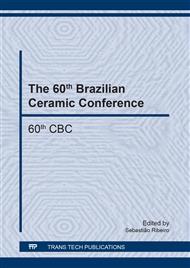p.65
p.71
p.77
p.82
p.87
p.93
p.97
p.102
p.106
Assessment of PCM-Impregnated Zeolite as a Matrix for Latent Heat Storage
Abstract:
In the context of energy economy and thermal comfort, phase change materials (PCMs) have many useful applications. In this study, type A zeolite was tested as a matrix for impregnating obtaining a PCM-impregnated zeolite. A sample of type A zeolite was analyzed by X-ray diffraction (XRD) and X-ray fluorescence (XRF). The porosity was evaluated by scanning electron microscopy. Following that, an apparatus was mounted for vacuum impregnation to incorporate calcium chloride hexahydrate (CaCl2.6H2O), which is a PCM, in the pores of the zeolite. The impregnation and the retention of the phase change material in zeolites were assessed using Fourier transform infrared spectroscopy (FTIR), energy dispersive spectroscopy (EDS) on the scanning electron microscopy (SEM) and Differential Thermal Analysis (DTA) to simulate thermal cycles testing to determine the thermal behavior of the compound. The results of the XRD and FTIR analyses showed that CaCl2.6H2O remains in the zeolite phase after the impregnation and the thermal cycling performed on the material shows that there is a positive influence on the thermal behavior of the impregnated material. Varying the amount of the studied PCM between 0 and 30 wt%, different grout boards were constructed. The thermal behavior of the PCM-impregnated zeolite compared to the reference material (pure zeolite) showed an effective temperature difference (38.1 to 33.9 °C), which can lead to significant energy savings.
Info:
Periodical:
Pages:
87-92
Citation:
Online since:
January 2018
Price:
Сopyright:
© 2018 Trans Tech Publications Ltd. All Rights Reserved
Share:
Citation:


